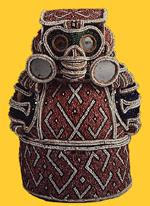United Nations, NY (UCTP Taino News) – One year ago, back in December 2004, the United Nations General Assembly adopted Resolution 59/174 establishing the Second International Decade of the World’s Indigenous Peoples. Although it may not be common knowledge, as a result of this resolution’s adoption, the Second Decade officially commenced on January 1st 2005. This resolution also requested that UN Secretary General Kofi Annan submit a report on a Comprehensive Program of Action for the Second International Decade to the sixtieth session of the General Assembly. The Program of Action was discussed and adopted by the General Assembly on November 21st 2005.
Highlighting the importance of participation within the international system, the program of action was developed based upon comments received from the UN system, governments, indigenous peoples' and civil society organizations. Twenty-two indigenous organizations provided input for the program of action. Among these submissions, the United Confederation of Taino People (UCTP) was the only entity representing Caribbean Indigenous Peoples to submit a formal proposal to be considered within this process. As a result of UCTP participation, the efforts of the Indigenous Peoples’ Caucus of the Greater Caribbean was also recognized within the official report. Based on consultations among regional representatives, the Indigenous Peoples Caucus of the Greater Caribbean submitted various interventions during the fourth session of the Permanent Forum on Indigenous Issues held in May 2005. The Caucus will reconvene at the next session to be held in May 2006.
UCTP President Roberto Mucaro Borrero stated “our participation within this process should make it clear that our people will not remain silent while governments, academics and others determine what they believe is in our best interest without our input or consent. All Caribbean governments and state-sponsored institutions need to not only respect our regional consultations and aspirations but they need to actively look for ways to work together with us in meaningful partnership as we are the First Nations of the region.”
The plan of action for the Second International Decade will rely on five key objectives which cut across the various areas of the main goal for the Decade established by the General Assembly, namely strengthening international cooperation for the solution of problems faced by indigenous people in the areas of culture, education, health, human rights, the environment and social and economic development. Those objectives also cut across the means set by the General Assembly for the achievement of the goals, namely “action-oriented programmes and specific projects, increased technical assistance and relevant standard-setting activities.”
Within the plan of action, a specific reference regarding Caribbean Indigenous Peoples can be found under Section 6 “Social and Economic Development”, item (b) Regional level, number 86. The recommendation suggests that “representatives of Caribbean indigenous peoples should be included in region-specific consultations and conferences in Latin America and the Caribbean, and on steering committees for planning and implementing the programme of activities for the Second International Decade. Serious consideration should also be given to organizing a special regional consultative session focusing on the unique situation of Caribbean indigenous peoples, which would take place in the Caribbean, hosted by a Member State and a local indigenous community.”
“This recommendation derives directly from the UCTP submission, which was based on consultations with regional representatives” stated Borrero. “This is a reference that community representatives can now use to lobby their local and national governments.”
The plan of action is available for review at the website of the Permanent Forum on Indigenous Issues in various languages.
Highlighting the importance of participation within the international system, the program of action was developed based upon comments received from the UN system, governments, indigenous peoples' and civil society organizations. Twenty-two indigenous organizations provided input for the program of action. Among these submissions, the United Confederation of Taino People (UCTP) was the only entity representing Caribbean Indigenous Peoples to submit a formal proposal to be considered within this process. As a result of UCTP participation, the efforts of the Indigenous Peoples’ Caucus of the Greater Caribbean was also recognized within the official report. Based on consultations among regional representatives, the Indigenous Peoples Caucus of the Greater Caribbean submitted various interventions during the fourth session of the Permanent Forum on Indigenous Issues held in May 2005. The Caucus will reconvene at the next session to be held in May 2006.
UCTP President Roberto Mucaro Borrero stated “our participation within this process should make it clear that our people will not remain silent while governments, academics and others determine what they believe is in our best interest without our input or consent. All Caribbean governments and state-sponsored institutions need to not only respect our regional consultations and aspirations but they need to actively look for ways to work together with us in meaningful partnership as we are the First Nations of the region.”
The plan of action for the Second International Decade will rely on five key objectives which cut across the various areas of the main goal for the Decade established by the General Assembly, namely strengthening international cooperation for the solution of problems faced by indigenous people in the areas of culture, education, health, human rights, the environment and social and economic development. Those objectives also cut across the means set by the General Assembly for the achievement of the goals, namely “action-oriented programmes and specific projects, increased technical assistance and relevant standard-setting activities.”
Within the plan of action, a specific reference regarding Caribbean Indigenous Peoples can be found under Section 6 “Social and Economic Development”, item (b) Regional level, number 86. The recommendation suggests that “representatives of Caribbean indigenous peoples should be included in region-specific consultations and conferences in Latin America and the Caribbean, and on steering committees for planning and implementing the programme of activities for the Second International Decade. Serious consideration should also be given to organizing a special regional consultative session focusing on the unique situation of Caribbean indigenous peoples, which would take place in the Caribbean, hosted by a Member State and a local indigenous community.”
“This recommendation derives directly from the UCTP submission, which was based on consultations with regional representatives” stated Borrero. “This is a reference that community representatives can now use to lobby their local and national governments.”
The plan of action is available for review at the website of the Permanent Forum on Indigenous Issues in various languages.









